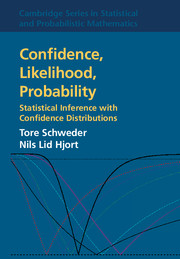Book contents
- Frontmatter
- Dedication
- Contents
- Preface
- 1 Confidence, likelihood, probability: An invitation
- 2 Inference in parametric models
- 3 Confidence distributions
- 4 Further developments for confidence distribution
- 5 Invariance, sufficiency and optimality for confidence distributions
- 6 The fiducial argument
- 7 Improved approximations for confidence distributions
- 8 Exponential families and generalised linear models
- 9 Confidence distributions in higher dimensions
- 10 Likelihoods and confidence likelihoods
- 11 Confidence in non- and semiparametric models
- 12 Predictions and confidence
- 13 Meta-analysis and combination of information
- 14 Applications
- 15 Finale: Summary, and a look into the future
- Overview of examples and data
- Appendix: Large-sample theory with applications
- References
- Name index
- Subject index
15 - Finale: Summary, and a look into the future
Published online by Cambridge University Press: 05 March 2016
- Frontmatter
- Dedication
- Contents
- Preface
- 1 Confidence, likelihood, probability: An invitation
- 2 Inference in parametric models
- 3 Confidence distributions
- 4 Further developments for confidence distribution
- 5 Invariance, sufficiency and optimality for confidence distributions
- 6 The fiducial argument
- 7 Improved approximations for confidence distributions
- 8 Exponential families and generalised linear models
- 9 Confidence distributions in higher dimensions
- 10 Likelihoods and confidence likelihoods
- 11 Confidence in non- and semiparametric models
- 12 Predictions and confidence
- 13 Meta-analysis and combination of information
- 14 Applications
- 15 Finale: Summary, and a look into the future
- Overview of examples and data
- Appendix: Large-sample theory with applications
- References
- Name index
- Subject index
Summary
In this final chapter we first highlight some main points from previous chapters, with emphasis on interpreting confidence as epistemic probability. Various other theories of epistemic probability and evidential reasoning are then briefly reviewed, and we discuss how Bayesian methods relate to confidence distribution methods in statistical theory and practice. The final section identifies some issues in confidence theory that remain unresolved, of which the need for an axiomatic theory of epistemic probability, of the confidence distribution type, is far the most important and also the most challenging. It is clear that more statistical theory is needed! We echo Efron (1998) that confidence distributions might be the big hit in the years to come, both in statistical theory and practice. But the proof of the pudding is in the eating, and by clarifying the concepts and methods of statistical inference based on confidence distributions, statistical practice in empirical sciences will hopefully improve.
A brief summary of the book
The table of contents (pages vii–xi) gives a condensed summary of the book. Instead of commenting in chronological order we here highlight the most important messages of the book. Our comments are selective and indeed incomplete.
Epistemic probability: Important but neglected
The 95% confidence interval for the Newtonian gravitational constant G based on the CODATA 2010 is (6.6723,6.6754) in appropriate units (Milyukov and Fan, 2012). Thus, P(6.6723 < G < 6.6754) = 0.95. Statements like the latter have been condemned by non-Bayesian statisticians since Neyman (1941): the G is not a random variable, but a natural constant. It is thus either true or false, according to the hard-core frequentists, that G ∈ (6.6723,6.6754), and the probability for such an event must therefore either be zero or one. This condemning message has been hard to convey to students and researchers, as it is contrary to common sense. We should, in our view, stop this practice. By acknowledging that there are two distinct types of probability, and that the statement P(6.6723 < G < 6.6754) = 0.95 is one of epistemic probability, and not about the outcome of a real or imagined experiment, it makes perfect sense. It does also make sense to say that the null hypothesis is false with probability 0.98 when the p-value is 0.02.
- Type
- Chapter
- Information
- Confidence, Likelihood, ProbabilityStatistical Inference with Confidence Distributions, pp. 418 - 436Publisher: Cambridge University PressPrint publication year: 2016



